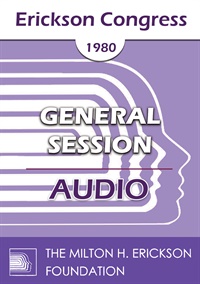
- Average Rating:
- Not yet rated
- Topic Areas:
- General Sessions | Ericksonian Hypnosis and Therapy Techniques
- Categories:
- Erickson Congress | Erickson Congress 1980
- Faculty:
- Charles R Stern, PhD | Peter Nemetschek | Richard Van Dyck, MD
- Duration:
- 2:00:48
- Format:
- Audio Only
- Original Program Date:
- Dec 08, 1980
- Short Description:
- IC80 General Session 15 - Ericksonian Approaches in Therapy - Charles R Stern, PHD, Peter Nemetschek, Richard Van Dyck, MD
- Price:
- $15.00 - Base Price
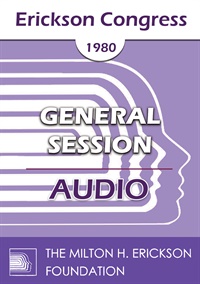
- Average Rating:
- Not yet rated
- Topic Areas:
- General Sessions | Ericksonian Hypnosis and Therapy Techniques | Language of Hypnosis
- Categories:
- Erickson Congress | Erickson Congress 1980
- Faculty:
- Donna M Spencer, MSW | Stephen Lankton, MSW
- Duration:
- 1:52:58
- Format:
- Audio Only
- Original Program Date:
- Dec 08, 1980
- Short Description:
- IC80 General Session 16 - Ericksonian Approaches in Language - Donna M Spencer, MSW, Stephen R Lankton, ACSW
- Price:
- $15.00 - Base Price
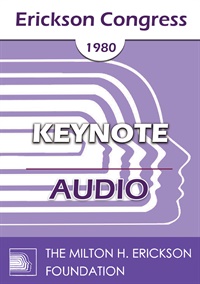
- Average Rating:
- Not yet rated
- Topic Areas:
- Keynotes | Psychotherapy | Ericksonian Hypnosis and Therapy Techniques
- Categories:
- Erickson Congress 1980 | Erickson Congress
- Faculty:
- Jay Haley, MA
- Duration:
- 1:01:07
- Format:
- Audio Only
- Original Program Date:
- Dec 05, 1980
- Short Description:
- IC80 Keynote 01 - Erickson's Contribution to Change in Psychotherapy - Jay Haley, MA
- Price:
- $15.00 - Base Price
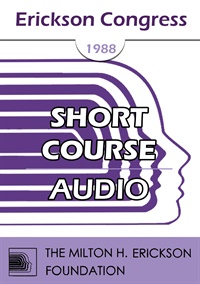
- Average Rating:
- Not yet rated
- Topic Areas:
- Children and Adolescent Therapy | Ericksonian Hypnosis and Therapy Techniques | Trance
- Categories:
- Erickson Congress | Erickson Congress 1988
- Faculty:
- Gary Ruelas, DO, PhD
- Duration:
- 1 Hour 28 Minutes
- Format:
- Audio Only
- Original Program Date:
- Dec 11, 1988
- Short Description:
- Short Course 37 - The Entrancement of Children, Developmental Assessment and Treatment of Children and Youth - Gary Ruelas, MA
- Price:
- $15.00 - Base Price

- Average Rating:
- Not yet rated
- Topic Areas:
- Clinical Demonstrations | Ericksonian Hypnosis and Therapy Techniques | Ericksonian Psychotherapy | Utilization | Humor | Hypnosis | Psychotherapy
- Bundle(s):
- Pioneers of Psychotherapy Bundle
- Categories:
- Pioneers of Psychotherapy | Evolution of Psychotherapy | Evolution of Psychotherapy 1995
- Faculty:
- Jeffrey Zeig, PhD
- Course Levels:
- Master Degree or Higher in Health-Related Field
- Duration:
- 00:57:00
- Format:
- Audio and Video
- Original Program Date:
- Dec 14, 1995
- Short Description:
- Zeig (1995) demonstrates the Ericksonian approach to psychotherapy while working with Carol, a woman whose nail-biting habit is rooted in anxiety. After gathering information on her personal history, Zeig helps Carol utilize her values and history to affect change. The process is both humorous and dramatic. After working to change associations linked to the problem behavior, Zeig offers Carol an ordeal that will produce a "guaranteed cure." Hypnosis is offered as the "dessert", rather than the main course. Ericksonian approach to psychotherapy.
- Price:
- $59.00 - Base Price
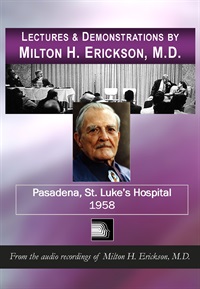
- Average Rating:
- Not yet rated
- Topic Areas:
- Clinical Demonstrations | Milton Erickson | Ericksonian Hypnosis and Therapy Techniques | Hypnosis
- Categories:
- Erickson Materials | Lectures & Demonstrations | Milton H. Erickson Collections
- Faculty:
- Milton H. Erickson, MD
- Duration:
- 7:01:11
- Format:
- Audio Only
- Original Program Date:
- May 02, 1958
- Short Description:
- Dr. Erickson does a lecture and demonstration at Pasadena, St. Luke’s Hospital 1958
- Price:
- $62.00 - Base Price
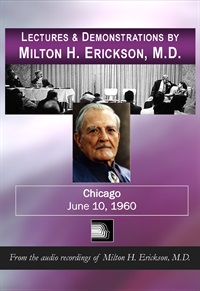
- Average Rating:
- Not yet rated
- Topic Areas:
- Hypnosis | Ericksonian Hypnosis and Therapy Techniques | Milton Erickson | Binds | Resistance
- Categories:
- Erickson Materials | Lectures & Demonstrations | Milton H. Erickson Collections
- Faculty:
- Milton H. Erickson, MD
- Duration:
- 3:57:01
- Format:
- Audio Only
- Original Program Date:
- Jun 10, 1960
- Short Description:
- During this seminar, Dr. Erickson describes essential skills for working with resistant patients, the use of permissive language, ordeal therapy, geometric progression, and therapeutic double binds. Erickson conducts a demonstration, answers questions from the audience, and elaborates on his thinking with case illustrations that include: sexual dysfunction, stuttering, bed wetting, childhood eating disorders, compulsive habits, phobias and self-defeating behavior.
- Price:
- $40.00 - Base Price
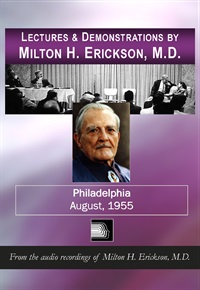
- Average Rating:
- Not yet rated
- Topic Areas:
- Hypnosis | Milton Erickson | Dissociation | Unconscious Processes | Ericksonian Hypnosis and Therapy Techniques
- Categories:
- Erickson Materials | Lectures & Demonstrations | Milton H. Erickson Collections
- Faculty:
- Milton H. Erickson, MD
- Duration:
- 2:17:27
- Format:
- Audio Only
- Original Program Date:
- Aug 01, 1955
- Short Description:
- In this set, Erickson communicates the timeless principles of hypnosis that he observed, discovered and utilized. He emphasizes the paramount importance of protecting the patient and establishing trust as the very foundation of the cooperative relationship characteristic of hypnosis. He stresses the importance of understanding the meaningful need of the patient and reviews, with many examples, the techniques of rehearsal, uncovering, dissociation, regression, time-distortion, revivification, visualization, orientation to the past and to the future, trusting the unconscious mind, and post-hypnotic suggestion.
- Price:
- $20.00 - Base Price
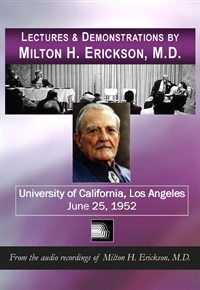
- Average Rating:
- Not yet rated
- Topic Areas:
- Hypnosis | Milton Erickson | Ericksonian Hypnosis and Therapy Techniques | Hypnotic Phenomena
- Categories:
- Erickson Materials | Lectures & Demonstrations | Milton H. Erickson Collections
- Faculty:
- Milton H. Erickson, MD
- Duration:
- 5:32:57
- Format:
- Audio Only
- Original Program Date:
- Jun 25, 1952
- Short Description:
- Five hours of instruction by Dr. Erickson on two general topics: Control of Psychological Functions by Hypnosis and Hypnotic Approaches to Therapy.
- Price:
- $62.00 - Base Price
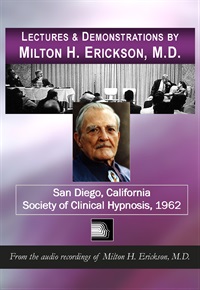
Lectures & Demonstrations of Milton H. Erickson, MD – San Diego - Society of Clinical Hypnosis, 1962
- Average Rating:
- Not yet rated
- Topic Areas:
- Hypnosis | Milton Erickson | Ericksonian Hypnosis and Therapy Techniques | Family Therapy | Pain and Healing | Sex and Sexuality
- Categories:
- Erickson Materials | Lectures & Demonstrations | Milton H. Erickson Collections
- Faculty:
- Milton H. Erickson, MD
- Duration:
- 5:29:03
- Format:
- Audio Only
- Original Program Date:
- Apr 29, 1962
- Short Description:
- Audio recording of Dr. Erickson describing essential differences between traditional hypnosis and modern hypnosis.
- Price:
- $50.00 - Base Price
Please wait ...

